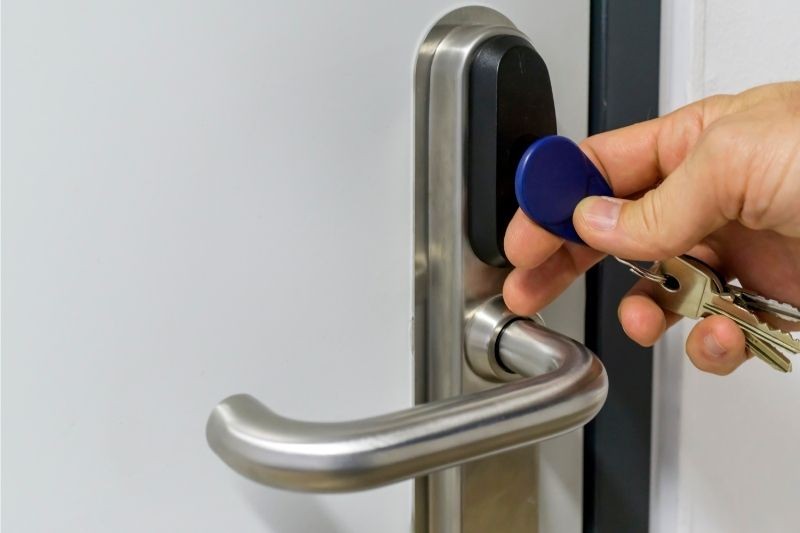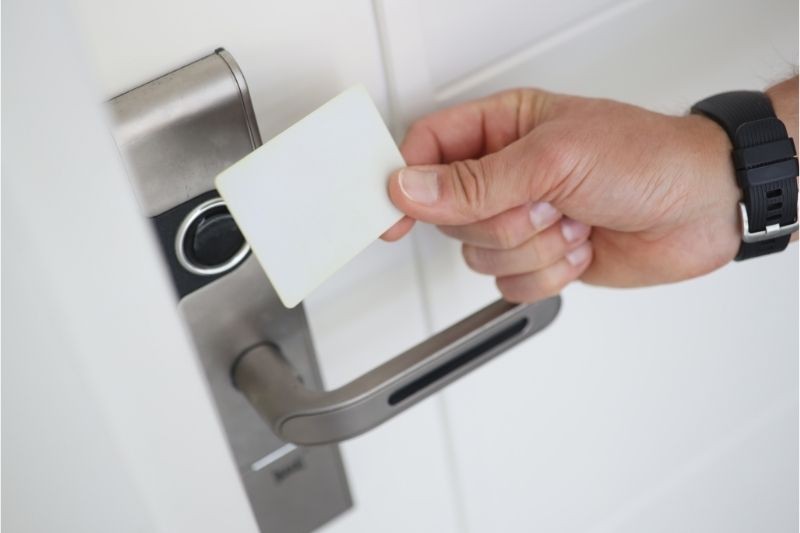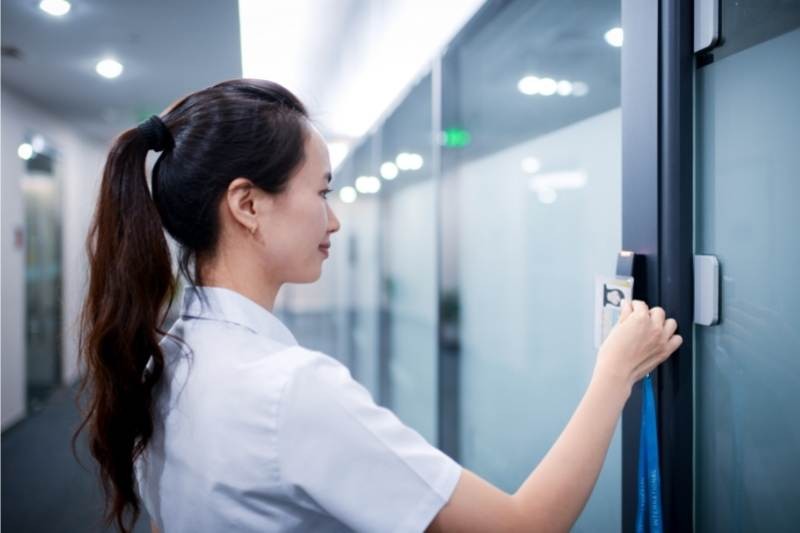Controlling access to your commercial property is paramount for security and operational efficiency. You need a system that’s both user-friendly for authorized personnel and robust enough to deter unauthorized entry. Commercial key fob door lock systems are a popular choice, known for their ease of use. However, are they the best solution for your business, and how do you find the right “Commercial Key Fob Door Lock System Near Me”? This guide will delve into the intricacies of key fob systems, explore different types of commercial door locks, and help you determine if a key fob entry system is the right fit for your building, and where to find local providers.
This post covers:
Understanding Commercial Key Fob Door Lock Systems
A commercial key fob door lock system is an electronic locking mechanism activated by a key fob. This fob can be a remote-like device with buttons or a scannable tag utilizing RFID (Radio-Frequency Identification) technology. Essentially, it’s a modern take on access control, replacing traditional keys with electronic credentials.
But let’s clarify: What exactly is a key fob system for commercial buildings?
In the context of commercial buildings, a key fob system is an electronic access control system. It involves distributing key fobs to authorized users – employees, staff, or tenants – who then use these fobs to unlock designated doors. The functionality is similar to key card systems, but instead of cards, users employ key fobs.
Key Components of a Commercial Key Fob Door Lock System:
- Access Reader: This is the device installed at the door that scans the key fob. It’s the interface between the fob and the locking mechanism.
- Key Fobs (Access Credentials): These are the electronic keys. They contain a chip or sensor that communicates with the access reader.
- RFID Door Lock: This is the electronic lock itself. It remains locked until it receives a signal from the access reader upon successful fob authentication. It uses electromagnetic fields to interact with the reader.
Common Applications in Commercial and Industrial Settings:
Commercial key fob systems are versatile and can be implemented across various areas within commercial and industrial properties, including:
- Restricted Utility Rooms
- Management and Private Offices
- Individual Office Suites
- Shared Amenity Spaces
- Employee Restrooms
- Secure Rooftop Access Points
- Maintenance and Storage Areas
How Commercial Key Fob Door Lock Systems Function
Commercial key fob door lock systems operate using either electric or magnetic locking mechanisms to secure doors. The process is straightforward:
- Fob Scan: An authorized user presents their key fob to the access reader mounted at the door.
- Credential Verification: The reader utilizes RFID technology to read and verify the credential encoded in the key fob.
- Door Release: If the fob’s credential is valid and recognized by the system, the access reader sends a signal to the electronic door lock. This signal triggers the lock to release, allowing the user to open the door.
See a demonstration of how a system like ButterflyMX works:
Distinguishing Features of Commercial Door Locks
Commercial door locks, including key fob systems, are engineered for heavy-duty, industrial applications. They are prevalent in environments with high traffic and stringent security needs, such as office buildings, industrial warehouses, hospitals, and various commercial real estate developments. A “commercial-grade” lock signifies the highest tier of lock quality, designed for enhanced security, superior durability, and crafted with higher-quality materials compared to residential-grade locks.
Cost Considerations for Commercial Key Fob Locks
The investment in a commercial key fob lock system typically ranges from $1,300 to $2,000, excluding professional installation costs. Furthermore, replacement key fobs can cost anywhere from $50 to $400 each. When budgeting for a system, it’s crucial to account for the number of key fobs required, especially in buildings with multiple tenants or a large workforce, as each authorized user will need a fob.
Weighing the Pros and Cons of Key Fob Door Lock Systems for Commercial Use
Before deciding on a commercial key fob door lock system for your property, it’s essential to evaluate the advantages and disadvantages to determine if it aligns with your specific security and operational requirements.
| Advantages of Commercial Key Fob Door Lock Systems | Disadvantages of Commercial Key Fob Door Lock Systems |
|---|---|
| Rapid Entry: Key fobs enable quick and efficient access for authorized personnel, minimizing delays and improving workflow. | Loss and Theft Vulnerability: Similar to traditional keys, key fobs can be easily lost or stolen, posing a security risk if not promptly deactivated. |
| Simplified Installation: Compared to more complex systems, key fob door locks are generally easier to install, reducing initial setup time and costs. | Not Hands-Free: Key fobs require physical interaction for access, which may be inconvenient in situations where hands-free entry is preferred. |
| Offline Operation: These systems do not depend on constant WiFi or Bluetooth connectivity, ensuring reliable operation even during network outages. | Limited Guest Access Features: Standard key fob systems typically lack built-in mechanisms for easy guest access management. |
| Cost-Effective Credentials: Key fobs are relatively inexpensive to procure and replace compared to some other access credential types. | No Smartphone Integration: Basic key fob systems do not offer smartphone-based entry options, which are increasingly desired for convenience and advanced features. |



In conclusion, commercial key fob systems offer a marginal improvement over traditional keyed locks. Their primary advantage lies in the speed of entry, eliminating the fumbling associated with physical keys. However, for areas requiring basic access control within a building, such as staff-only zones, they can still be a practical and effective security measure.
Exploring Alternatives to Commercial Key Fob Door Lock Systems
While key fob systems provide a basic level of electronic access control, several alternative systems offer enhanced features and functionalities for commercial properties:
- Commercial Keypad Door Locks: These locks utilize numerical keypads or touchscreens for entry, requiring users to input a code for access.
- Smart Locks for Commercial Buildings: Smart locks are electronic locks that can be controlled remotely via smartphones and often integrate with mobile apps for advanced management.
- Keypad Access Control Devices: These are standalone access control units that can be installed alongside existing door locks. Some keypad systems also offer smartphone integration for expanded access options.
Discover how ButterflyMX keypads enhance access control:
Why Consider ButterflyMX Keypads?
For commercial properties seeking a comprehensive access control solution that goes beyond basic key fob functionality, the ButterflyMX Keypad emerges as a superior alternative. This modern, smartphone-centric system streamlines both tenant and visitor access management.
Key Advantages of the ButterflyMX Keypad:
- Simplified Guest Access: Tenants can easily grant temporary access to visitors by issuing temporary PIN codes remotely, enhancing convenience and security.
- Easy Integration and Installation: The ButterflyMX Keypad is designed for straightforward installation, typically connecting to existing electronic door strikes.
- Integrated Security Camera: Each access attempt via the keypad triggers a camera to capture an image and log user information, bolstering security and providing an audit trail.
- Automatic Software Updates: The system receives automatic software updates via internet connectivity, ensuring optimal performance and automatic bug fixes.
- Cloud-Based Management: Tenant data and access logs are securely stored in the cloud, enabling remote management and monitoring.
- Smartphone-Enabled Access: Authorized users can utilize their smartphones as access credentials, offering a convenient and modern entry method, and grant guest access directly from their devices.
[